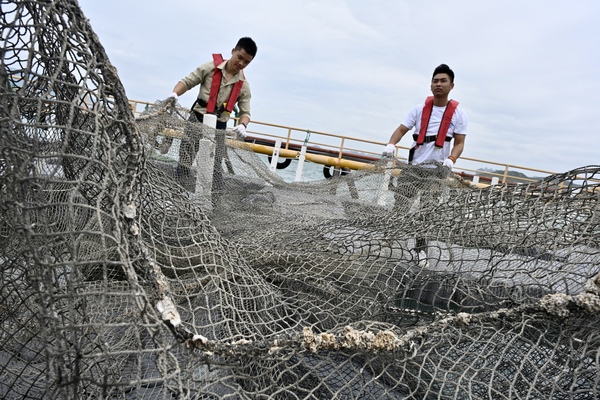Sustainable Fisheries - A Win-win

Sustainable fisheries and aquaculture make an important contribution to Hong Kong by way of maintaining a steady supply of fresh fish to local consumers.
To promote the upgrading and transformation as well as modernisation and sustainable development of Hong Kong’s mariculture industry, the Agriculture, Fisheries & Conservation Department (AFCD) plans to progressively launch four new fish culture zones.
Vital zones
The four new zones will be located in Wong Chuk Kok Hoi, outer Tap Mun, Mirs Bay and Po Toi (Southeast). The total area of the zones, situated in open waters with better currents, is about 590 hectares.
To resist strong winds and waves that may occur in the new zones, the department suggests using steel truss cages, or other types of deep sea cages, designed to fit Hong Kong’s hydrology and environment.
The department set up a modern mariculture demonstration farm at Tung Lung Chau to showcase how the steel truss cages can help boost the industry.
Modern technology
Different from the traditional mariculture rafts made from wood, the giant cages have a lot of advantages.
“It is more durable than the wooden-made mariculture rafts. Its estimated lifespan is 25 years. With an aquaculture water volume of about 11,000 cubic metres, this enables the farm to harvest 300 tonnes of aquatic products per year,” AFCD Senior Fisheries Officer Chow Wing-kuen said.
Deep sea cages will be set up at the new fish culture zones and the farms there will be equipped with modern aquaculture systems that feature automated feeding and a real-time monitoring system. Such equipment will allow the operation to function at maximum efficiency.
Polytechnic University Research Institute for Future Food Associate Director Kevin Kwok discovered that by using the steel truss cages, both the growth and survival rates of the fish are better than the ones raised via the traditional wooden rafts. The steel cages provide the fish with better water quality as their excrement is easily washed away by natural water currents. The fish also contain a lot of healthy omega-3 fatty acids.
Apart from conducting research at the demonstration farm at Tung Lung Chau, the Polytechnic University also provides hands-on training there to conventional mariculturists and those who wish to join the industry.
Trainee Jack Mui said he and other apprentices learnt how to feed the fish, how to distinguish fish illnesses, etc. He added that the AFCD and the Polytechnic University staff taught them many useful skills and techniques and also helped them build up a professional network of the fisheries industry. He has eventually started his own business together with his peers.
Altruistic goal
“Weather can sometimes make working outdoors a challenge. Even though colleagues are exposed to the sun and rain, or work till late at night, they do not complain. All we strive to do, is accomplish the goal of demonstrating the model of modernisation and the sustainable development of the fisheries industry.” Chow Wing-kuen added.
Adaptive System Optimises Traffic Flow
In a bustling city like Hong Kong, waiting for traffic lights to change to green is an inevitable part of life, especi... Read more
Drone Sports Add To Low-altitude Buzz
Alongside the Government’s push to develop Hong Kong’s low-altitude economy, drone sports have been gaining in pop... Read more
Construction Robots Enhance Efficiency
For the Trunk Road T2 & Cha Kwo Ling Tunnel project, the Civil Engineering & Development Department has applie... Read more
HK's Smart Development Recognised
Hong Kong has placed significant emphasis on smart transformation and development in recent years – and its efforts ... Read more
Hotline Eases Carers' Burden
Mrs Lee, 74, and her 84-year-old husband are a doubleton elderly household relying on Comprehensive Social Security As... Read more
District Governance: Cameras Boost Security
Whether at busy intersections or tranquil street corners, Hong Kong has silent sentinels safeguarding citizens. Thr... Read more

